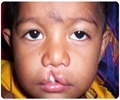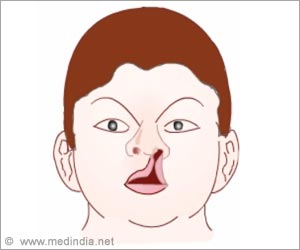Study identifies variants in our genome that are likely to contribute to craniofacial abnormalities.

Clefts of the mouth and face affect up to 1 in 500 people, making it one of the most common birth defects. Sometimes the cleft is just a small indentation of a person's lip, while in other cases the cleft splits deeply into the lip, upper palate and even the nose. And most of the time, a person with a cleft has no other malformations of the bones or other organs.
A few genes have been associated with facial clefts, but they account for only a very small number of cases.
"They're not like other disorders caused by mutation in a gene. Generally those are syndromes, affecting multiple organ systems. In most clefting cases, there is nothing else wrong," says Justin Cotney, an assistant professor of genetics and genome sciences at UConn Health. He studies the human genome, but not the genes that tell the body what proteins to make. Instead, he focuses on regulators, parts of the DNA that tell genes when and where to act. These regulators, also known as enhancers, tend to be linked to specific parts of the body.
"We thought clefting cases might be frequently caused by a disruption of one of these regulatory pieces of DNA," Cotney says. Enhancers are still poorly understood. They are located throughout the genome and it is often unclear which genes they control, potentially over very long distances. "Even though we have the whole human genome sequence, identifying enhancers and understanding what they do is akin to trying to work from a map written in an alien language," he says.
Cotney's lab has now begun to decipher that map.
Advertisement
In their paper, the researchers were able to home in on enhancers that, when deleted, are likely to cause Van Buchem Disease, a severe bone thickening disorder, or Pierre Robin Syndrome, a collection of craniofacial abnormalities including clefting. In all, Cotney's team found thousands of previously unknown enhancers that are likely involved in building the skull and the face. They go on to show that these enhancers are more common near parts of our DNA previously associated with clefting as well as normal differences in the way human faces look.
Advertisement
"We've found a large amount of the regulatory architecture for craniofacial development," Cotney says. "Now we can begin to understand which variants in our genome are likely to contribute to craniofacial abnormalities. In the future, we hope these annotations will help scientists to develop targeted therapies to correct or prevent these defects during pregnancy."
Source-Eurekalert










